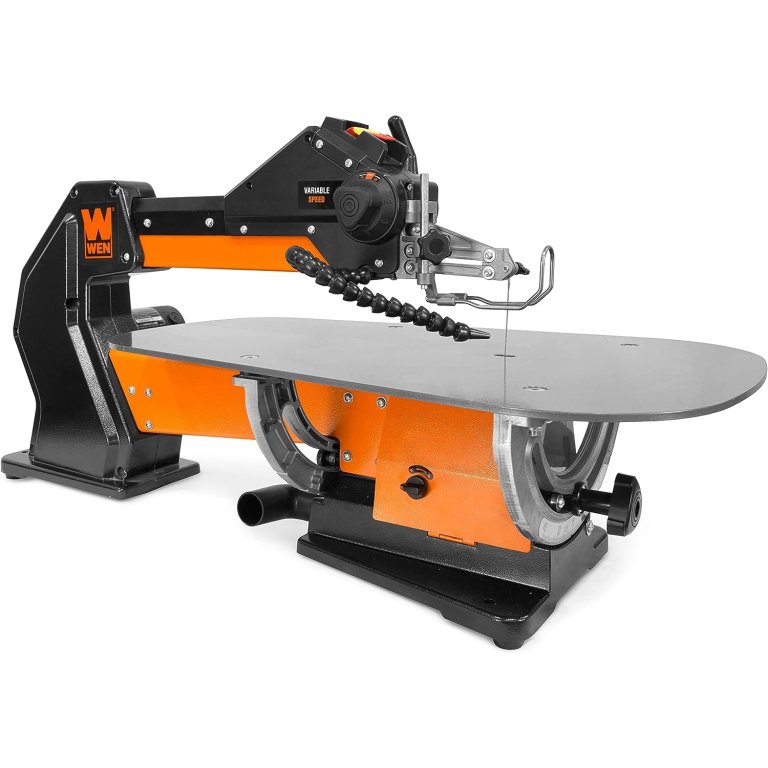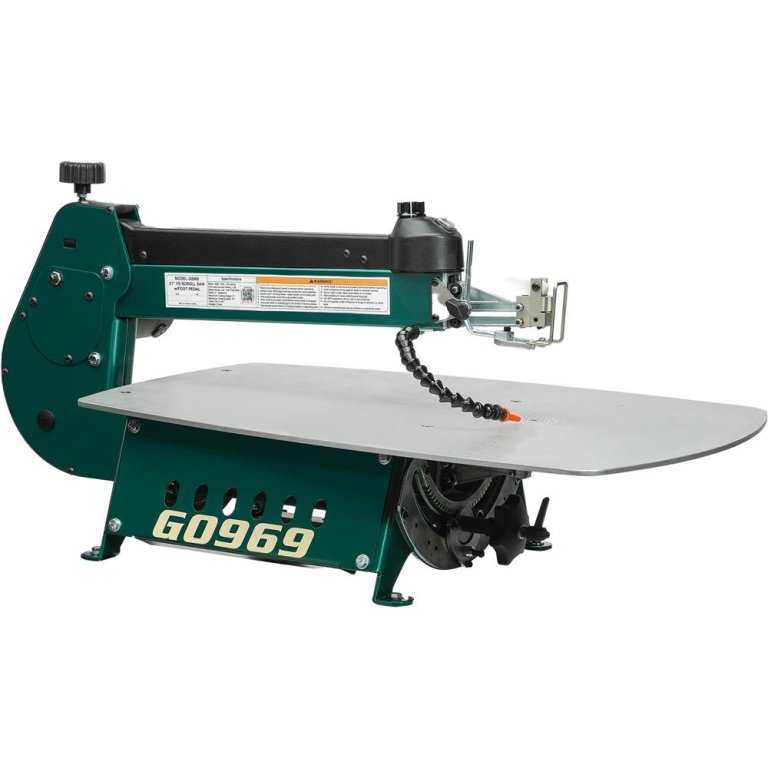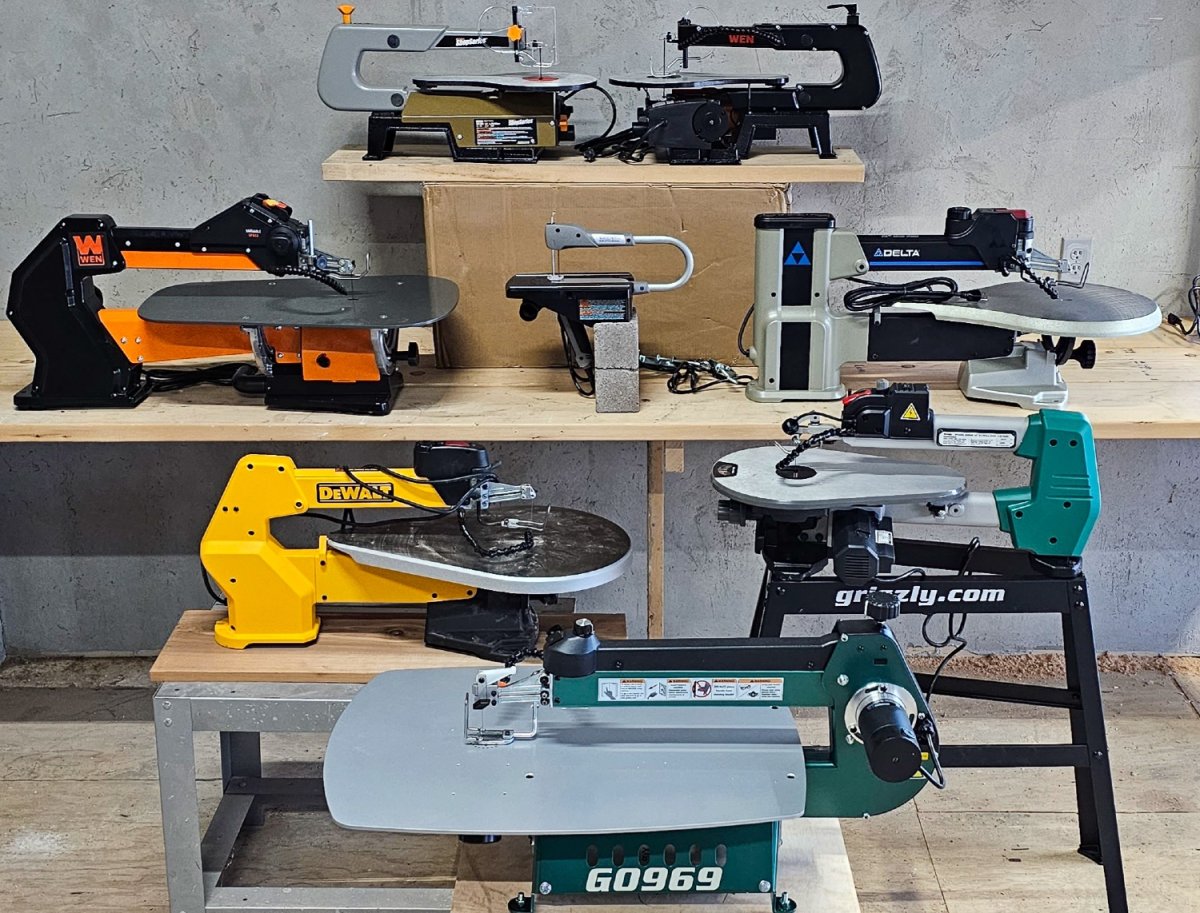
We may earn revenue from the products available on this page and participate in affiliate programs. Learn More ›
If you need to make precise cuts for projects like jewelry boxes, wood signs, or birdhouses, a scroll saw is probably the tool to use. Considered essential tools for woodworking, these specialty saws are particularly indispensable for craftspeople and artisan woodworkers who want to add finer details to their work. And typically, scroll saws leave level edges, so minimal sanding is necessary to achieve smooth finishes.
As with other power tools, scroll saw technology has been improving in recent years. We wanted to know just how good today’s models are, so we decided to test them in our own woodworking shops. We carefully researched 20 highly rated scroll saws, selecting the seven best contenders for hands-on testing. From there, we chose our favorites in various categories, some suitable for pros, others for beginner woodworkers.
Ahead, learn what to look for when shopping for a scroll saw and find out how the following models earned a spot on our lineup of the best scroll saws.
- BEST OVERALL: DeWalt 20-Inch Variable-Speed Scroll Saw
- BEST BANG FOR THE BUCK: Rockwell ShopSeries 16-Inch 1.2-Amp Scroll Saw
- UPGRADE PICK: Delta 20-Inch Variable Speed Scroll Saw
- BEST FOR INTERMEDIATES: Grizzly Industrial 18-Inch Scroll Saw With Stand
- BEST USER-FRIENDLY: Wen 21-Inch 1.6-Amp Scroll Saw With Dual-Bevel Table
- BEST PORTABLE: Dremel Moto-Saw Variable Speed Compact Scroll Saw Kit
- BEST FOR PROS: Grizzly 21-Inch Variable-Speed Scroll Saw
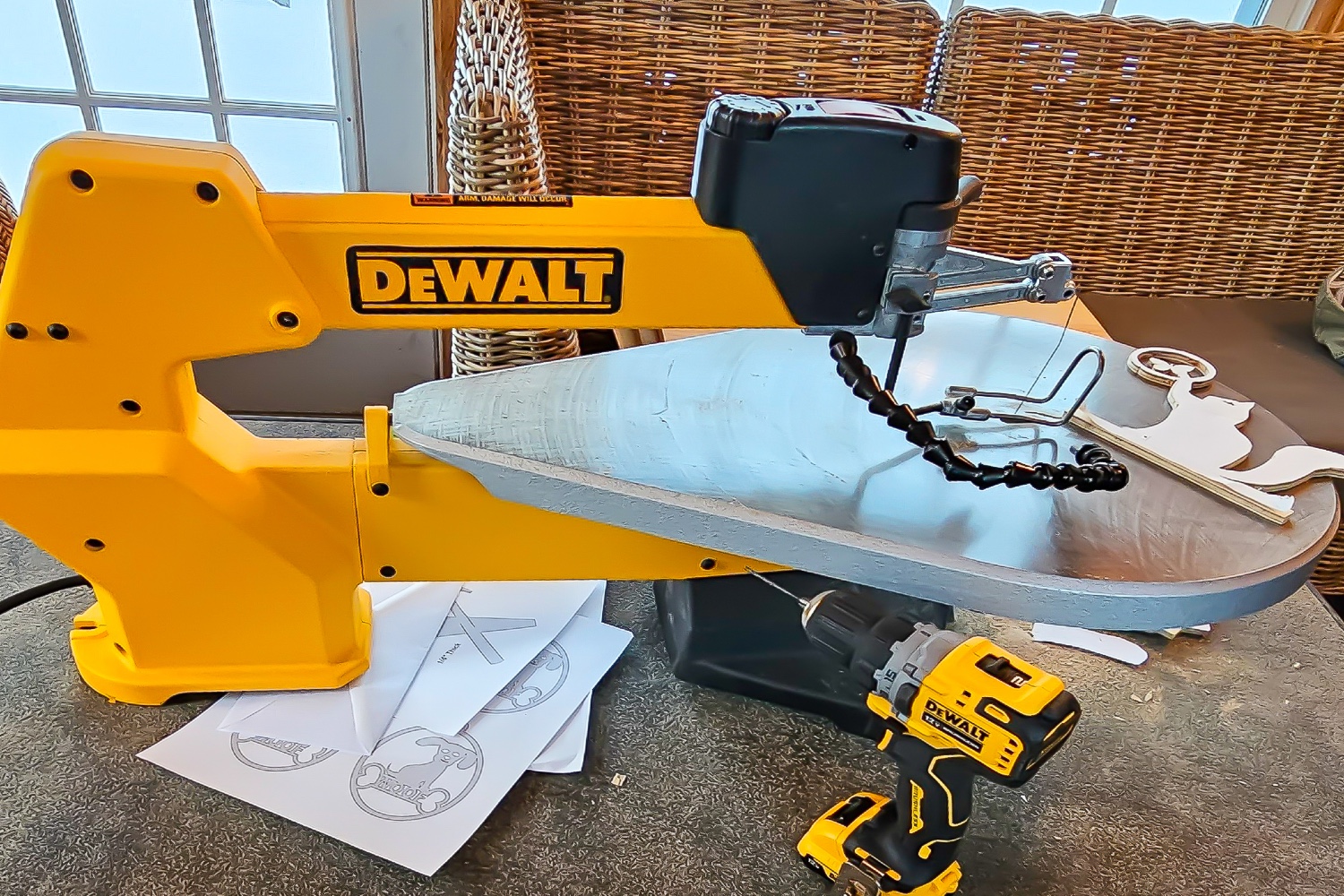
How We Tested the Best Scroll Saws
We’re not master scrollers, such as those craftspeople who create elaborate, intricate fretwork projects without making even the tiniest mistakes. We’re in awe of those artisans, but we’re not that talented. What we are is woodworkers who are well-versed in a wide range of power tools, including scroll saws.
We began by researching highly rated scroll saws, such as those made by DeWalt and Grizzly. While we took brand names into account to an extent, we didn’t automatically eliminate lesser-known manufacturers if their saws were well received by consumers. After curating a list of the top 20 scroll saws, we selected seven we wanted to test.
For testing, we assembled and mounted the saws in our workshops and then used them to cut both hardwood and softwood. Although some scroll saws are also capable of cutting other materials, such as plastic or sheet metal, we limited our tests to wood to compare performance equally across all the models. We tried out every feature on every saw and noted important factors, such as vibration levels.
We awarded points based on a rubric: The better a saw performed on a specific test, the more points it received. After testing, we averaged each saw’s points and used these calculations to determine the best uses and categories for each model.
Our Top Picks
We tested the most popular scroll saws on the market to create this lineup of the best scroll saw picks. The following saws vary by price, weight, features, and best uses, but each one earned its spot on this lineup by excelling in our hands-on tests. One will surely be right for your woodshop or as a gift for your favorite scroller.
Best Overall
DeWalt 20-Inch Variable Speed Scroll Saw
See ItWhat We Like
- Variable-speed control makes this tool suitable for both softwoods and hardwoods
- Tool-free blade changing is a handy feature for large projects requiring constant new blades
- Large 20-inch throat depth is ideal for most home and professional projects
What We Don’t Like
- At 56 pounds, this could be an armful to move around a shop
- While the arm lifts for easy blade change, it doesn’t stay up by itself, which can be slightly unhandy
Product Specs
- Throat depth: 20 inches
- Bevel: 45 degrees in both directions
- Speed: 400 to 1,750 SPM
- Maximum cutting depth: 2 inches
- Additional features: Flexible dust blower hose
This Bob Vila Approved product carries our brand’s highest level of recommendation.

Bob Vila Approved recognizes the household and DIY products that impressed us most in our real-world testing and that exemplify core values of the Bob Vila brand, including craftsmanship, innovation, and value for the dollar. Winners of this designation come recommended by our professional review team and are personally approved by Bob Vila.
With an impressive 20-inch throat capacity and adjustable speed, the 20-inch DeWalt scroll saw is an attractive choice for serious wood artisans as well as intermediates and novices. It’s designed to minimize vibration, and in our testing, it cut smoothly at both ends of its speed range, which is adjustable from 400 to 1,750 strokes per minute (SPM).
The DeWalt scroll saw features a thin yet strong metal hold-down foot that didn’t block our line of sight. The flexible blower hose offered just the right amount of air pressure to keep the cutting area free from accumulated dust as we worked.
We also liked this saw’s design layout. The on/off switch, the tension lever, and the speed adjustment are all located within easy reach, so we were able to make adjustments quickly when necessary and continue cutting.
The 20-inch throat depth makes the scroll saw suitable for cutting large workpieces. Also, the saw accepts plain-end (pinless) blades, and blade changes were relatively easy thanks to the toolless blade clamp. But this is where we wish DeWalt would make a change by adding a stop that holds the arm up. This would be helpful when users need to thread the saw blade through a center hole in the workpiece (known as fretwork). That was the primary change we would suggest; lacking a stop, we manually braced the arm by wedging a board under it while we threaded the blade through the workpiece.
We tested the DeWalt on softwood (pine) and hardwood (oak), and it excelled on both. The saw table tilts 45 degrees in both directions for precise bevel cuts. This all-purpose scroll saw can also be used with a stand (sold separately), which might be a good idea considering this saw weighs 56 pounds. We didn’t test the stand—instead, we bolted the saw to a workbench, which put it at just the right height to operate while standing or sitting on a high stool.
Read our full review: DeWalt 20-Inch Variable-Speed Scroll Saw
Get the DeWalt scroll saw at Amazon, Ace Hardware, The Home Depot, or Acme Tools.
Best Bang For The Buck
Rockwell ShopSeries 16-Inch 1.2-Amp Scroll Saw
See ItWhat We Like
- Simple design for beginners; fairly easy to set up and get started
- Additional safety shield helps minimize accidental cuts or injuries during use
- Built-in blade storage keeps the blades organized when stored
What We Don’t Like
- Only bevels in 1 direction; can become awkward to bevel an entire project
Product Specs
- Throat depth: 16 inches
- Bevel: 45 degrees, single direction
- Speed: 500 to 1,700 SPM
- Maximum cutting depth: 2.5 inches
- Additional features: Onboard blade storage, dust blower
This budget-friendly Rockwell ShopSeries scroll saw offers most things a beginner would need to create intricate projects. The saw features a 16-inch throat depth and offers variable cutting speed from 500 to 1,700 SPM so that users can cut various materials. What especially caught our attention about this one was its attractive price point.
It also comes with a table that tilts 45 degrees to the left (though it doesn’t bevel to the right). In testing, we noticed slightly more vibration than with some of the higher-end models, but that can be reduced by carefully adjusting the cutting speed to suit the type and thickness of the wood as well as by bolting the saw down to a workbench. We were able to accurately make straight and curved cuts. The ShopSeries is lighter than some competitive models (37.5 pounds), so it can be moved to various locations in a woodshop without too much trouble.
This scroll saw comes with a clear plastic safety shield that makes it safer for novice users, but we found we had to remove the shield periodically to clean it because dust built up on the inside. Still, it’s a welcome safety feature that makes this affordable saw an excellent option for the young or beginning scroll saw artisan.
While it may not be a professional-grade power tool, it allowed us to make intricate cuts nonetheless. The arm does not lift for blade changing, but the saw features a removable base plate that allowed us to easily fit blades into the lower blade holder. Another bonus was that this saw was relatively quiet while running. Though we didn’t use a decibel tester to measure the sound level, it was noticeably quieter than some other saws we tested.
Get the Rockwell scroll saw at Amazon, The Home Depot, or Woodcraft.
Upgrade Pick
Delta 20-Inch Variable Speed Scroll Saw
See ItWhat We Like
- Pro-grade tool provides high precision; great for adding fine details to projects
- Bevels 45 degrees left and right; allows users to make impressive professional cuts
- Very little to no unwanted vibration—operation is smooth and relatively quiet
- Onboard blade storage helps keep tool parts together and organized
What We Don’t Like
- No dust collection; workshops without a shop vac may get messy
Product Specs
- Throat depth: 20 inches
- Bevel: 45 degrees, both directions
- Speed: 400 to 1,750 SPM
- Maximum cutting depth: 2.125 inches
- Additional features: Onboard blade storage, flexible dust blower
For a scroll saw with enough power and versatility to routinely tackle pro-level jobs, check out this variable-speed scroll saw from Delta. It features a 20-inch throat capacity, adjustable speed, a table that tilts 45 degrees to the left or right, and an air blower. Stroke speed adjusts from 400 to 1,750 SPM, and the adjustment knob is located on the front of the saw arm in a spot we found was extra handy to use while cutting—no reaching required.
The upper arm lifts and locks out of the way during blade changes; this is something we wished all the scroll saws had. The ability to lock the arm in the lifted position allowed us to easily thread blades through the center holes in fretwork patterns without the arm being in the way.
This scroll saw accepts plain-end blades and features a thin metal hold-down foot that doesn’t block the line of sight—the hold-down foot is slightly on the flimsy side, but this certainly is a professional-grade saw. Professionals often remove that feature to have greater control over the movement of the wood.
We cut pine and oak boards, and the Delta saw excelled with both. The cut areas of the wood were smooth and needed only minimal sanding. We noticed almost no vibration with this saw. It operates so smoothly, and part of that reason is due to its muscular build—it weighs a hefty 70 pounds!
The speed adjustment, tension control, and power switch are all located on the front of the tool. The only downside is the lack of a dust-collection port, but it’s not a deal-breaker. For intermediate and advanced scrollers, the Delta is an excellent upgrade saw that deserves a permanent spot in the wood shop.
Get the Delta scroll saw at Amazon, Lowe’s, The Home Depot, or Acme Tools.
Best For Intermediates
Grizzly Industrial 18-Inch Scroll Saw With Stand
See ItWhat We Like
- Bevels up to 45 degrees in both directions, making it versatile for most scrolling projects
- Bright gooseneck LED light can be directed at cutline for improved visibility
- Comes with a sturdy iron stand, making it handy for users who don’t have space to permanently mount the saw
- Bevel angle gauge on the top of the table makes choosing the angle of cut effortless
What We Don’t Like
- Stand is sturdy, but there’s the potential for tipping if the stand is bumped
Product Specs
- Throat depth: 18 inches
- Bevel: 45 degrees, both directions
- Speed: 450 to 1,500 SPM
- Maximum cutting depth: 2.25 inches
- Additional features: Stand included, bevel angle gauge, LED light
Grizzly’s 18-inch scroll saw is a top-notch pick for users who have developed some scrolling skills and are ready to take their projects to the next level. This high-quality tool features a couple of accessories other saws don’t have. For that reason and others, we had a lot of fun testing this power tool.
This midrange Grizzly saw comes with an adjustable LED light that we found very useful for bright illumination on the cutlines of our test boards. We wish all scroll saws had this because not all workshops are adequately lit, and it’s so much easier to make precise cuts when the cutlines can be seen clearly. In addition, this saw offers nearly vibrationless cutting and comes with a sturdy metal stand. Alternatively, it can also be bolted to a workbench.
We cut oak and pine boards with this saw, and it did well with both. Changing blades is similar to most of today’s other scroll saws: Just insert the bottom blade followed by the top blade, and secure them with thumbscrews. We found it easy to thread the blade through our fretwork patterns.
The Grizzly bevels up to 45 degrees in both directions. But here’s where the saw really shines: The built-in bevel-angle gauge on the top edge allows users to select the exact angle they want without having to scrunch under the table to set the bevel. We found this thoughtful feature very helpful.
The saw offers variable-speed cutting ranging from 450 to 1,500 SPM, which makes it suitable for making intricate cuts in various wood types and thicknesses. The 18-inch throat depth is ample for most projects, and being able to mount the saw on the stand makes it suitable for those who do not have adequate workbench space for mounting.
Get the Grizzly 18-inch scroll saw at Amazon, The Home Depot, or Grizzly Industrial.
Best User-Friendly
Wen 21-Inch 1.6-Amp Scroll Saw With Dual-Bevel Table
See ItWhat We Like
- Features a flip-open side panel that provides easy access for under-table blade changes
- All essential controls—speed knob, power switch, and blade tensioner—are conveniently located at the front of the saw arm
- Exceptional build quality and very little vibration, providing stable cutting and comfortable operation
- Cuts cleanly, leaving edges smooth to reduce the need to sand
What We Don’t Like
- Right-side bevel is limited to 30 degrees, while left-side bevel is 45 degrees
Product Specs
- Throat depth: 21 inches
- Bevel: 45 degrees left, 30 degrees right
- Speed: 550 to 1,600 SPM
- Maximum cutting depth: 2 inches
- Additional features: Dust port, flexible dust hose, side panel access for blade changes
Scroll saw artisans with large hands may sometimes find it challenging to change blades in the restricted under-table spaces on some scroll saws. That won’t be an issue with Wen’s 21-inch scroll saw. This powerful precision cutting tool features a flip-open side panel that lifts up and out of the way, making it a breeze to reach in and fit new blades into the blade clamp.
Blade-change ease isn’t the only perk of this midrange scroll saw. The Wen also features a large-capacity 21-inch throat depth and a solid steel table that easily supports large-format projects. All the controls—variable-speed knob, power switch, and blade tensioner—are located within easy reach at the front of the unit, so there’s no need to stop the saw to reach around and make adjustments. They can simply be made on the fly instead.
While Wen is not commonly counted among the top manufacturers of professional power tools, this 21-inch scroll saw is right up there with the top brands in terms of performance. We were pleasantly surprised to find this saw’s build quality exceptional. We appreciated how smoothly it ran, producing little to no vibration at every speed.
The only downside—and it is slight—is that the dual-bevel only goes to 30 degrees on the right side. It bevels a full 45 degrees on the left. Fortunately, this will not be a deal-breaker for most intermediate and advanced scrollers because most angles are cut at less than 30 degrees. If the user needs more than a 30-degree cut to the right, it’s always possible to turn the workpiece over and cut the angle on the left side.
This saw powered smoothly and quietly through soft pine and hard oak, leaving immaculate edges that required only minimal sanding. This saw is a winner for those looking for high-quality performance from a user-friendly scroll saw. It could easily become a favorite of even seasoned scrollers.
Get the Wen scroll saw at Amazon, Lowe’s, or The Home Depot.
Best Compact
Dremel Moto-Saw Variable Speed Compact Scroll Saw Kit
See ItWhat We Like
- Excellent versatility; detaches from base for coping projects as well as scrollwork
- Portability—weighs just 2.4 pounds and comes in a hard case that protects it during transport
- Variable speed makes this small saw suitable for various materials and cutting requirements
What We Don’t Like
- Limited surface area makes this saw unsuitable for cutting large-format projects
- While very effective for small on-the-fly cuts, the saw will not replace a wood shop scroll saw
Product Specs
- Throat depth: 9.84 inches
- Bevel: No
- Speed: 1,500 to 2,250 SPM
- Maximum cutting depth: 0.75 inch
- Additional features: Clamp-on base, dust port, built-in table guides
If you’ve ever needed a scroll saw to make just a few cuts but didn’t want to go to the workshop, the Dremel Moto-Saw might be just what you’re looking for. This compact power tool weighs just 2.4 pounds and comes with a hard case that protects it when transporting it between sites.
We had never used a scroll saw like this before, and initially, we were skeptical about its ability to make precision cuts. We were wrong. The Dremel scroll saw has some limitations, such as not having a sizable surface area to support large-format projects, but it easily cuts small workpieces.
The saw comes with two clamps for securing it to a tabletop or workbench, and once the clamps are tightened, the saw can cut materials up to 0.75 inch thick without issue. It features quick-blade-change clamps and a variable-speed knob. The power switch and speed switch are located on the base handle, which seemed slightly inconvenient at first, but as we worked with the saw, we learned where the controls were by touch.
This model doesn’t make bevel cuts, but that’s not surprising for a compact saw of this nature. However, it does double duty as a coping saw. We simply removed it from the workbench and held the base handle to cut a coping joint on a piece of crown molding.
The Moto-Saw is a little noisy, but that’s a trade-off for the portability factor. The stroke speed is very fast—1,500 to 2,250 SPM—and we wished we could have selected a slightly slower speed when we cut through oak because we got a little too much vibration even at the lowest speed. The Moto-Saw will not replace a larger woodshop scroll saw, but that’s not what it was made for. It’s designed to make small cuts on the fly, and it works very well in that capacity.
Get the Dremel scroll saw at Amazon, The Home Depot, Walmart, or Acme Tools.
Best For Pros
Grizzly 21-Inch Variable-Speed Scroll Saw
See ItWhat We Like
- Saw arm tilts (rather than the table) to cut angles—similar to a miter saw
- Pressure-sensitive foot pedal keeps both hands free for controlling the workpiece
- Variable speed makes it possible to cut a variety of wood types and thicknesses
What We Don’t Like
- Limited portability—weighing in around 100 pounds, this saw is best suited to a dedicated spot in the workshop
Product Specs
- Throat depth: 21 inches
- Bevel: 45 degrees, both directions
- Speed: 400 to 1,550 SPM
- Maximum cutting depth: 2 inches
- Additional features: Tilt cutting arm for bevels, floor pedal, dust port
The second Grizzly scroll saw to earn a spot on this lineup, this 21-inch powerhouse comes with upgraded features that serious scrollers will love.
Like most of the other saws we tested, this formidable Grizzly cuts up to 45-degree bevels in both directions. But interestingly, the table doesn’t tilt; the cutting arm does. This is similar to how a miter saw works, and after trying it, we can honestly say that this is the best way to cut bevels. We greatly preferred keeping our workpiece horizontal while cutting bevels. This reduced the risk of any unwanted slipping of the workpiece while the tilted cutting arm made precise angled cuts.
Advanced angle-cutting isn’t the only upgraded difference we found with the Grizzly. It also comes with a pressure-sensitive foot pedal, so we were able to control the speed of the blade by increasing or decreasing foot pressure. Plus, the pedal comes with bolt-down holes we used to secure it to our workshop floor, so it didn’t move during the testing process.
Cutting speed on this scroll saw ranges from 400 to 1,550 SPM, so we were able to cut easily through soft and hardwoods. The cut edges were smooth and required minimal sanding.
There was no discernable vibration with this Grizzly saw, and much of that is likely due to its heft. This saw weighs around 100 pounds, and it doesn’t move or shift during operation. It’s stable, solid, and very secure. This bear of a saw deserves a dedicated spot in a professional scroller’s woodshop where both the saw and the pedal can be secured in place. It will not disappoint.
Get the Grizzly 21-inch scroll saw at Grizzly Industrial.
Jump to Our Top Picks
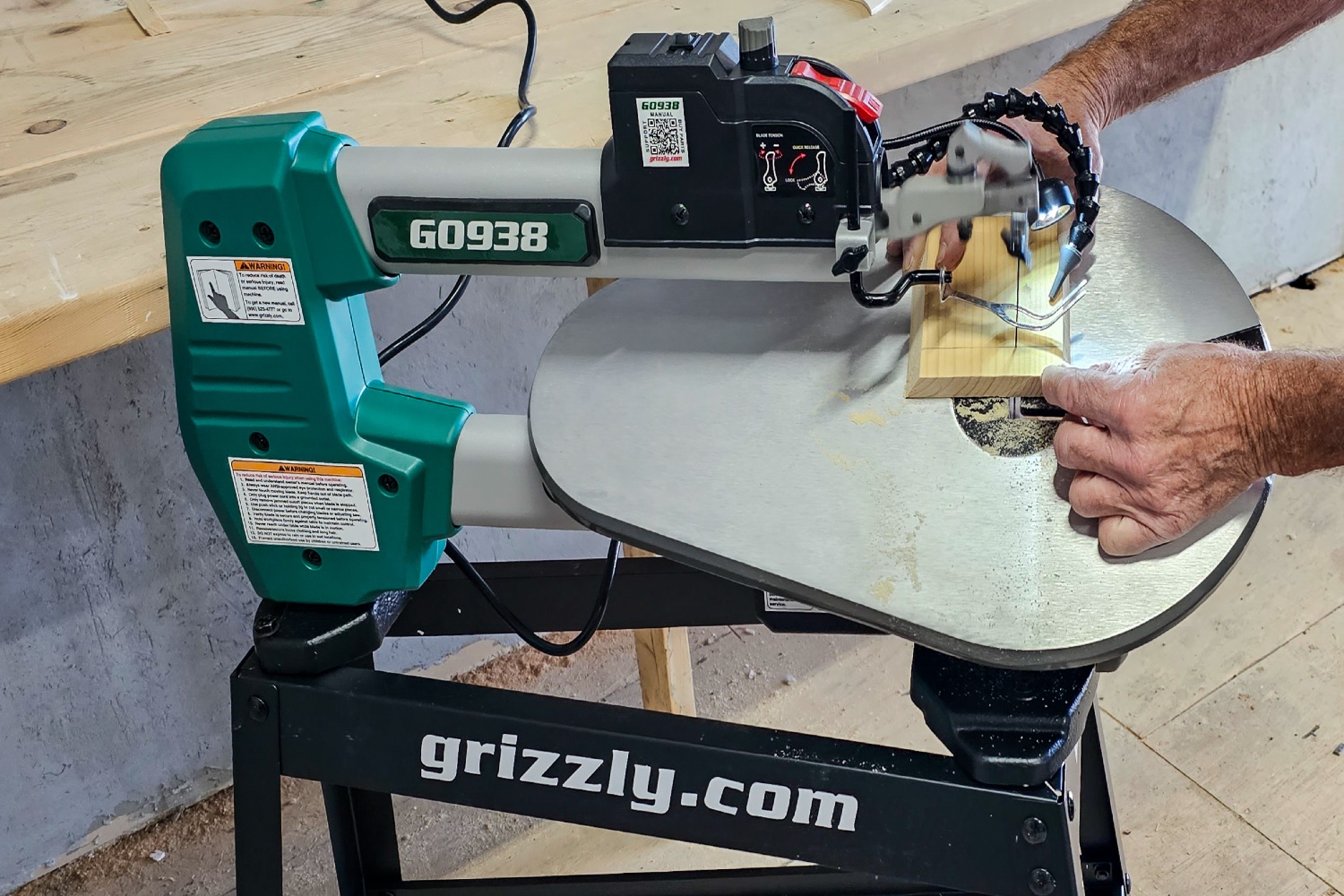
What to Consider When Choosing a Scroll Saw
Scroll saw prices usually start at around $125 but may top $1,000, depending on quality and features. Decent scroll saws for home woodworkers can be found for less than $500. The more expensive models are better suited to professional fabricators. Consider the following tool features while shopping and comparing various scroll saw models.
Type/Arm Design
Scroll saw type is determined by its arm design. A scroll saw’s arm holds the blade. There are three main types of scroll saw arm designs in use today: C-type, parallel, and parallel-linked.
- C-type scroll saws have one continuous C-shaped arm that moves in an up-and-down motion as one unit. There is one pivot point toward the rear of the C and a motor in the center of the C’s bottom. As the motor turns, it cranks the entire C up and down. These saws are low maintenance, aggressive, and fast, but they aren’t the most accurate.
- Parallel arm scroll saws have an upper arm and a lower arm that run parallel to each other, and each has its own pivot point toward the front. The back of each arm is attached to a tension rod or spring. These saws have shorter blade strokes than C-type saws, and although they cut more slowly, they’re far more accurate.
- A parallel-linked arm operates similarly to a parallel arm, but there are multiple pivot points. They’re a bit more aggressive than parallel arm scroll saws but also more detailed than a C-type saw, making them a nice meet-in-the-middle of the other two types.
Blade Type and Size
Scroll saws will accept two common types of very thin blades: “plain-end blades” or “pin-end blades.” Many of today’s scroll saws accept both types.
- Plain-end blades (also known as pinless blades) are held in place between jaws that clamp tightly at the top and the bottom of the blade (below the table of the saw). This is the most common type of blade acceptance, and a wide variety of plain-end blades are readily available for cutting different types of material, such as wood, plastic, and metal.
- Pin-end blades feature small cross pins at each end that fit into hooks. However, fewer varieties are available, which may impact the size of possible cuts. For example, if a narrow cut is needed, the cross pin at the end of the blade may be too wide to fit through the slit in the material.
By far, the most common nominal scroll saw blade length is labeled as 5 inches, though they can be as long as 5.5 inches in actual measurement. This 5-inch standard length fits most saws and is available in both end types. There are also 4-inch and 3-inch scroll saw blades, but they’re far less common and provide less cutting capacity for most cutting needs.
Blade Tension
A scroll saw comes with a control that allows a user to increase or decrease tension on the blade while working. With too much tension, the thin blade could snap. On the other hand, if the tension is too loose, the blade may twist while cutting and create a jagged edge on the workpiece.
On some saws, users can adjust a lever to set the blade tension. Other saws feature tension control knobs. Usually, a tension control that’s located on the front of a saw is preferable. If a saw has one on the back, users must move to the back of the saw to tweak the tension on the blade.
Throat Capacity
On a scroll saw, the throat capacity is the distance from the saw blade to the back frame. The deeper the throat capacity, the wider the material that can be cut. Some saws are designed with throat capacities as shallow as 12 inches, while larger commercial saws may have throat capacities as deep as 30 inches. A throat capacity of around 16 to 18 inches is usually sufficient for most home woodworking tasks. If the plan is to cut larger designs, opt for a saw with a deeper throat capacity.
Keep in mind that material can be rotated while cutting, so the maximum width of any material that a scroll saw can cut is about twice the saw’s throat capacity. For example, if the saw’s throat capacity is 16 inches, a 32-inch-wide board can be cut.
Hold-Down Foot
As a safety precaution, all scroll saws in the U.S. feature a hold-down foot that keeps the material being cut pressed firmly against the saw’s table while cutting. Not everyone appreciates this safety feature because a bulky hold-down foot can block a user’s vision while cutting.
To avoid any interference, some woodworkers remove the foot altogether. A safer option is to choose a saw with a hold-down foot made from strong yet thin metal. A bulky one can obscure more of the cutting area.
Dust Blower and Collection
A dust blower removes accumulated dust from the surface of the material so that it doesn’t build up around the blade and block the view of the cutline. Some models also feature dust collection, typically in the form of a port on the underside of the cutting table that attaches to a standard wet/dry shop-type vacuum.
Starting the shop vac before making cuts will suck up the dust as it goes. A dust-collection port helps keep dust out of the air in the workshop (and, more importantly, off of a drying finish).
Additional Features
There can be more to a scroll saw than just its design and capacity. The following features might make working with a particular saw a bit more convenient or precise.
- Bevel cutting: Many scroll saws offer tilting tables that allow cutting material to be positioned at an angle. This is handy for creating a beveled edge. Most saw tables tilt up to 45 degrees, usually to the left, but some tilt in both directions. Tilting both ways is a handy feature, but not essential; the material can be turned over to cut a bevel on the other side. Additionally, a newer type of scroll saw offers a head that tilts rather than a table that tilts.
- Variable speed: A scroll saw is rated by the maximum number of up-and-down blade strokes the tool can complete in a single minute. That can range from a low of 400 SPM to a high of 1,800 SPM. Softwoods such as cedar can be easily cut at 400 SPM, while hardwoods such as walnut are easier to cut at higher speeds. Scroll saws with variable-speed adjustments offer the best of both worlds.
- Work light: When looking at scroll saws, users may notice a small tube that snakes around to the edge of the blade. That is an LED light designed to illuminate the exact spot on the material to be cut. Bright lighting helps make the most accurate cuts. Most scroll saws now offer flexible tube task lighting.
- Stand: Most scroll saws sit on a benchtop, but there are models that affix to a stand. These stands allow the user to be closer to the workpiece while also maintaining a more comfortable standing position.
Tips for Using a Scroll Saw
It’s better to “feed” the saw than to force a piece of material across it. This means gently guiding the material across the blade and allowing the saw to do the work. Forcing materials through the saw can cause imperfect cuts, blade jams, and even permanent damage to the saw.
If cutting several pieces of the same shape, it helps to stack them on top of each other and make all the cuts simultaneously. Just be sure to go slowly, as the additional surface area will increase friction.
Scrolling often requires excellent attention to detail and small tolerances. Use plenty of light to see cutlines, the saw, and other details that might affect the result. If the saw comes with a work light, use it. If not, set up a small clamp light nearby.
- Feed the saw; don’t force it.
- Stack workpieces to cut several pieces of the same shape at once.
- Use plenty of light.
FAQs
That’s a lot of information on the best scroll saws, but you might have some lingering questions nonetheless. The following section aims to help. It’s a collection of some of the most frequently asked questions about the best scroll saws. Be sure to check for an answer to your question below.
Band saw blades are one continuous loop of steel and teeth, and they rotate in one direction. These thicker blades aren’t very good for detailed work. Scroll saws use small, straight, delicate blades that can cut small, intricate shapes more easily. Also, scroll saw blades move up and down rather than in a loop.
There are a few things to look for. First, make sure whichever model you choose has a large enough throat for your planned tasks. Larger pieces need larger throats. Second, decide if accuracy or speed are more important, and choose your saw type based on that information.
Yes, but some are very loud, so it’s a good idea to use hearing protection. Dust accumulation may also become problematic if the scroll saw does not include a built-in dust collector or your workshop does not have a shop vac.
Most scroll saws can handle workpieces up to 2 inches thick. Note, however, that hardwoods and other more durable materials may struggle to cut accurately at such a thickness.
The average top speed of a scroll saw is between 1,500 and 1,800 SPM. Many popular scroll saw models offer adjustable speeds to allow users to cut a variety of different materials.
Plywood and cedar are among the best woods to practice scroll sawing, as they’re relatively affordable and consistent in grain pattern. These woods are also soft enough to cut smoothly with most scroll saws.
You can, but it’s usually challenging. Straight cuts are easier with table saws or large band saws. Scroll saws are designed to be used for fine detail work and cutting intricate patterns.
Meet the Tester
Glenda Taylor is a product tester and writer specializing in the construction, remodeling, and real estate industries. She and her husband own a general contracting company, and Taylor is experienced in both residential and commercial building applications. She tests a wide range of power tools as well as other home improvement, household, and lawn-and-garden products.
Additional research provided by Tom Scalisi.







